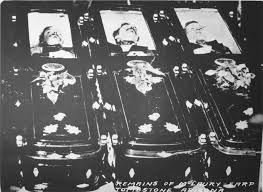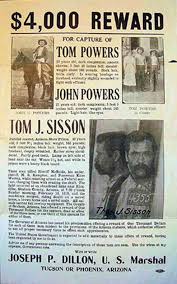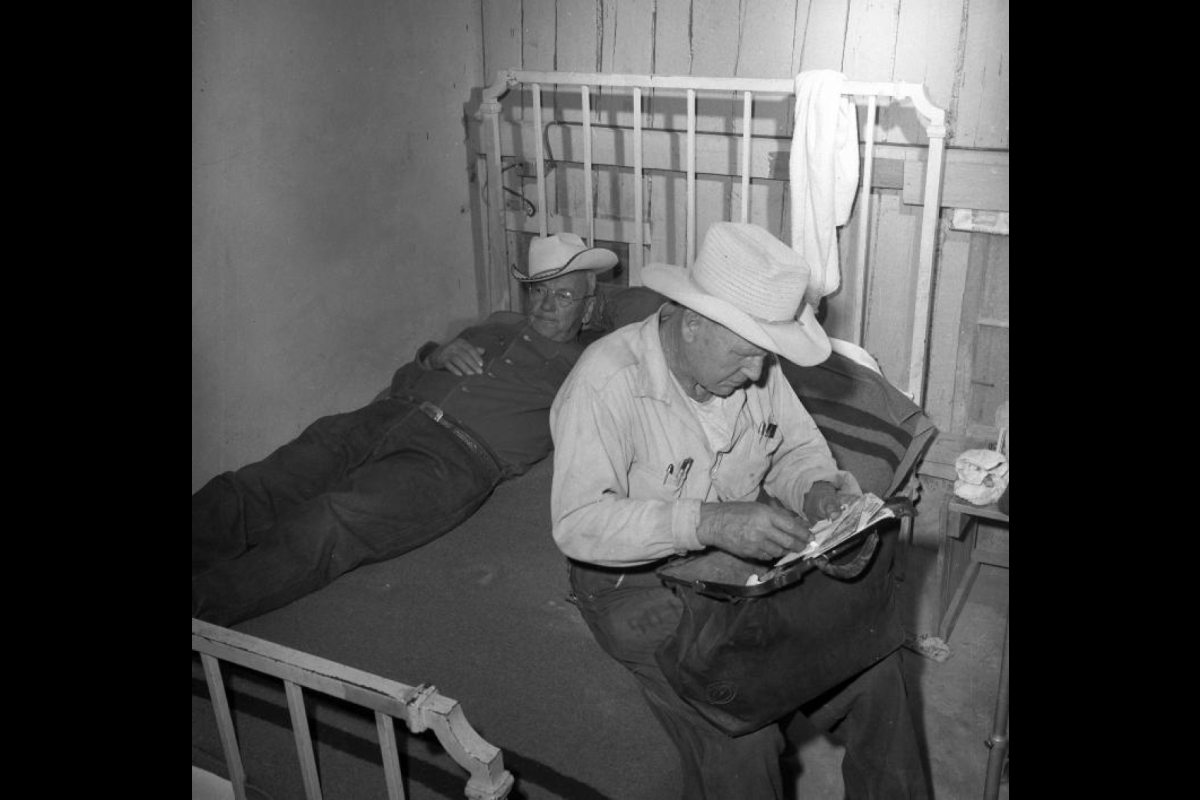2/10/1918 - Modern violence still going strong in Europe to the tune of millions of deaths while WWI enters its final year, Old Wild West gunfight bloodshed breaks out in the rugged Galiuro Mountains of southeast Arizona when lawmen try to arrest a group of miners for evading the military draft of able bodied men the United States government has instituted.

The Galiuro Mountains
Trying to extract a bit of Arizona's mineral wealth from the area for nine years is the Power family from Texas ... father Jeff, known as "The Old Man" (he is born in 1863), his wife, Martha, Jeff's mother, "Granny Jane" Power, and Jeff's progeny, three sons, Charles, John, and Tom, and a daughter, Ola May, all homesteading south of the settlement of Klondyke, on a patch of land in lower Rattlesnake Canyon (a community of over 300 individuals at the time, the area is now a ghost town of only five souls). After two years of hard work, the family has "upgraded" to a goat farm Charles buys, which in turn becomes a small cattle "ranch" that will become known as "Power Garden." Tragedy strikes the family though when Martha is killed when she is crushed by a collapsing cabin roof while visiting a neighbor in 1915 ... and it comes calling again when "Granny Jane" is killed in a run away buggy accident and then 22-year-old Ola May dying "from an unknown cause" (according to the Graham county coroner) on December 6, 1918 (there are rumors of poison, death from badly canned beans, a botched abortion and a broken neck, but no one seems to know for sure why the girl dies). For good or bad, the men of the Powers Family (less Charles, who moved away to New Mexico) are on their own.

The Powers Family - L to R - Jeff, Martha, Charles, Ola May, Tom, John
Goats and cattle both losers as viable enterprises for the family, by 1918 the Powers clan (with the assistance of a cowboy friend named Tom Sisson, a former U.S. Army scout) have become miners (made a dry state in 1914, they also dabble in bootleg liquor). Putting muscle and huge amounts of sweat into the effort of bettering themselves once again, Jeff purchases a quarter interest in an old abandoned gold mine in Keilberg Canyon, the family builds a twenty-five mile road to the mine, and after gaining control of three-quarters of the property, raises a cabin overlooking the mine's entrance (about two hundred yards away from the shaft) and acquire a second-hand stamp mill. Ready to begin operations in January, trouble instead comes their way when the United States government puts in a claim for the labor of Tom and John. American fighting in Europe about to begin, by the passage of the Selective Service Act of 1917, all able-bodied men between 21 and 30 are required to register for a military draft ... which the two Power boys do not do, either because they are told they don't have to by a local recruiter, or because their father convinces them that they are needed more personally for the family's mining operations (the maximum sentence for failing to register is one year in jail if found guilty ... a crime over 3,000,000 men will be guilty of during the war).

Keilberg Canyon

Power Family Cabin
Believing if they stay away from the authorities nothing will come of their noncompliance with the draft, the men ignore the warning they receive from the local county sheriff, two years in office, 43-year-old Robert Frank McBride (given to the men by the sheriff's proxy, a man named Jay Murdock), to come into town to register, and continue readying the site for ore extraction. But McBride is as serious as a heart attack in wanting his demands met and instead of ignoring the matter, with the Ola May mystery also in mind, arrest warrants are sworn out for Tom and John Power, and for questioning in the Ola May matter, against Jeff Power and Tom Sisson too (for perjury testifying about Ola May's death), and a compliance posse is formed consisting of McBride, Deputy Marshal Frank Haynes, and sheriff's deputies, 39-year-old Martin Kempton and 36-year-old Thomas K. "Kane" Wootan (heavily active in the area, unlike the Power clan, all four are members of the Mormon Church ... and there are rumors that Wootan had the hots for Ola May). Leaving Klondyke on February 9, the posse quietly arrive at the mine site after the sun has set, take up positions around the Power cabin and decide to await dawn before making their arrests. Spending their last peaceful night at the site, inside the cabin are all four of the men the posse are after.

McBride

Haynes

Kempton

Wooton
Unaware of the lawmen outside, just before dawn of Sunday, February 10, 1918, Jeff Power wakes up, gets a fire going in the cabin's fireplace and then starts a second blaze in the structure's wood burning stove. While he is engaging in readying the cabin for the morning (cold, it will begin snowing shortly after the gunfight concludes), the horses corralled outside begin making noises of agitation, which puts the men's dogs into a barking frenzy. Sensing something is wrong outside (he is thinking either a bear or a mountain lion is prowling about), the "Old Man" (he is 55-years-old) grabs his rifle and then steps through the east facing front door of the cabin. What happened next varies depending on what side is giving its "eyewitness" testimony later. Per the authorities, Jeff Power is told to "throw up your hands," twice by Wootan ... a request greeted by gunfire from someone within the cabin, but per Tom and John Power (and Sisson who claims to be sleeping when the battle begins and says he never fired a shot), their father is gunned down with no surrender demand given at all. Whomever started the clash, what is known is that gun chaos in the lightening dark soon follows (there is about a minute delay as everyone wakes up to what has just happened), and with bullets flying all about (at least 25 slugs are exchanged during the minutes long clash), Jeff Power goes down with a mortal wound to his chest, Tom Power receives wounds to the left side of his face after looking out a window for a target, Wooten is shot in the back and killed while running to a new firing position, Kempton is dropped outside the front door with a round to his stomach, wooden splinters wound John Power's eye and nose when a round hits the doorjamb the miner is lying beside, and McBride is killed while positioned at the northeastern corner of the cabin (he is hit by four bullets). Realizing he is outgunned, Haynes retreats from behind the cabin, reaches the posse's horses, mounts up and rides for Klondyke help as quickly as is possible (so fast and without rest that the horse he is on dies upon reaching the town). Over in just a few minutes, (most accounts have the encounter lasting between two to four minutes) the gunfight is the deadliest to the time in Arizona history with four men killed (only three men go down at the legendary Gunfight at the O.K. Corral) and leaves nineteen children fatherless.

John (L) And Tom (R) Power

Sisson

The Cabin

O.K. Corral Dead
Realizing for the first time (according to the Power Brothers) that the corpses outside are wearing badges, the three survivors make the snap decision to flee retribution and move south into Mexico, taking only their horses, weapons (for which they have 600 rounds of ammunition, chiefly from the posse's supplies), and a few meager supplies ... a decision which causes the biggest manhunt in the Arizona territory to that date. With posses roaming the state (there are thousands of dollars of reward money available), and three hundred soldiers from El Paso in on the hunt (in all, over 1,000 men will participate in the chase, along with the help of phones, telegraph lines, Apache scouts, pickup trucks, automobiles, bloodhounds, horses, and two airplanes), the men ride out of the area's canyons, gain the San Pedro River Valley, enter the Dragoon Mountains, cross Sulphur Springs Valley to the Chiricahua Mountains, move into New Mexico, and finally, south of the American town of Hachita, move into Mexico ... a winter odyssey over hundreds of miles of rugged wilderness terrain that lasts almost a month. But even in Mexico, the Power brothers and Sisson are not safe.

Headlines

Reward Poster
Blood up, despite their prey seemingly gaining international sanctuary, a small, unauthorized six-man unit of the 12th U.S. Cavalry, led by Lt. Wolcott P. Hayes continues the chase into Mexico ... more than 20 miles into the country. Cold, weary, hungry, dehydrated, clothes beginning to disintegrate, still injured from the gunfight (John has maggots in his wound and will lose his eye, Tom will keep his eye but lose sight from the damaged orb), Tom Power convinces his traveling companions that they should surrender. Stepping out of the scrub brush they are hiding in with arms raised, they so surprise and startle Hayes that he jumps off his horse trying to avoid gunfire that never comes, admitting the fugitives could have killed him with little trouble (asked later why the Power brothers and Sisson didn't, they will state they weren't murderers and wouldn't shot down a "soldier boy"). Brought back to the United States (there is almost another gunfight at the border between the soldiers and Mexican authorities irate at their border being violated), the men are put in the Safford, Arizona jail, but fearing a lynching when the jail is surrounded by an angry mob, moved north to the town of Clifton. Tried for first degree murder, the men plead self defense (they are defended by local lawyer, James Fielder), but it is their words against the testimony of Haynes, and Haynes is believed (during five days of testimony, Jeff Powers' dying statement to his sons about being shot by Wooton when his hands are up is not allowed, nor is evidence that McBride dies from bullets only one weapon is firing, a rifle belonging to one of the dead posse). Death penalty eliminated the year before by the new state (Arizona is admitted to the Union on February 14, 1912), a jury takes less than thirty minutes to reach guilty verdicts against all three or the men ... guilty and sentenced to life in prison without the possibility of parole (the wives of the dead lawmen are given the Power mine, which Mrs. McBride eventually running operations on the property for three decades). Off to their fates, only one of the three men will not leave the state prison at Florence.

Tom Jefferson Power

John Grant Power
Life in prison ... and yet the men eventually are allowed to participate in the prison's honor system (despite the brothers escaping to Mexico for three months while serving their sentence ... for which they will spend three months in solitary upon returning to the prison), helping milk cows, harvest nearby fields, build roads, and craft spurs and tack for sale (they receive $15 for every $100 they sell ... the state gets the rest), and Tom teaches himself how to read and write. And they all solely grow old. Never causing any problems, still a prisoner, Sisson eventually dies at the age of 87 in 1957. The brothers, however, live long enough that their cause is taken up by Arizona Republic journalist Don Dedra, After decades behind bars, at a 1960 hearing in which Morman hatred for the men is changed into Mormon forgiveness (three Morman bishops ask that clemency be granted the men, and Morman elder, a man in his 70s, orates in favor of releasing the brothers), Tom and John Power are both released from prison. Old men released into a modern world, highlights of the Power freedom include taking care of the goats and horses at a children's summer camp outside of Prescott, Arizona, a visit to Disneyland by Tom, and a 1970 full pardon from Arizona Governor John "Jack" Richard Williams in 1970 (an act that they respond to be immediately registering to vote). Tom dies in 1970 in San Francisco, California a the age of 77. His brother John, passes at the age of 85 in 1976 while living in Arizona's Aravaipa Valley.

Tom And John Just Before Their Release

Williams
And least anyone forget the bloody morning in Arizona history from so long ago, in 1975 the Power Cabin is placed on the National Register of Historic Places ... and in the Klondyke cemetery where "Old Man" Jeff Power is buried, the long dead miner's tombstone reads, "Shot down with his hands up in his own door."

The Historic Site












